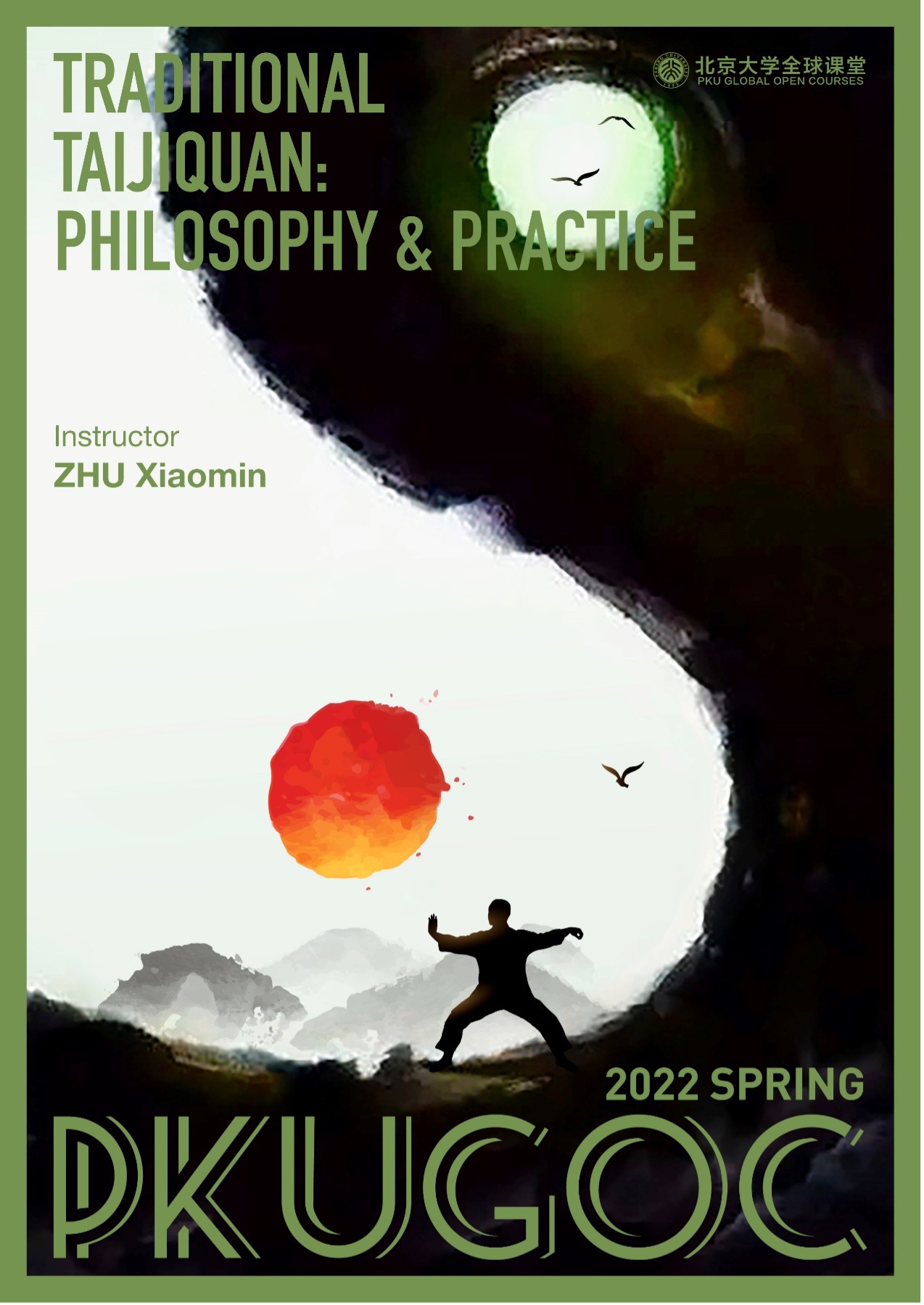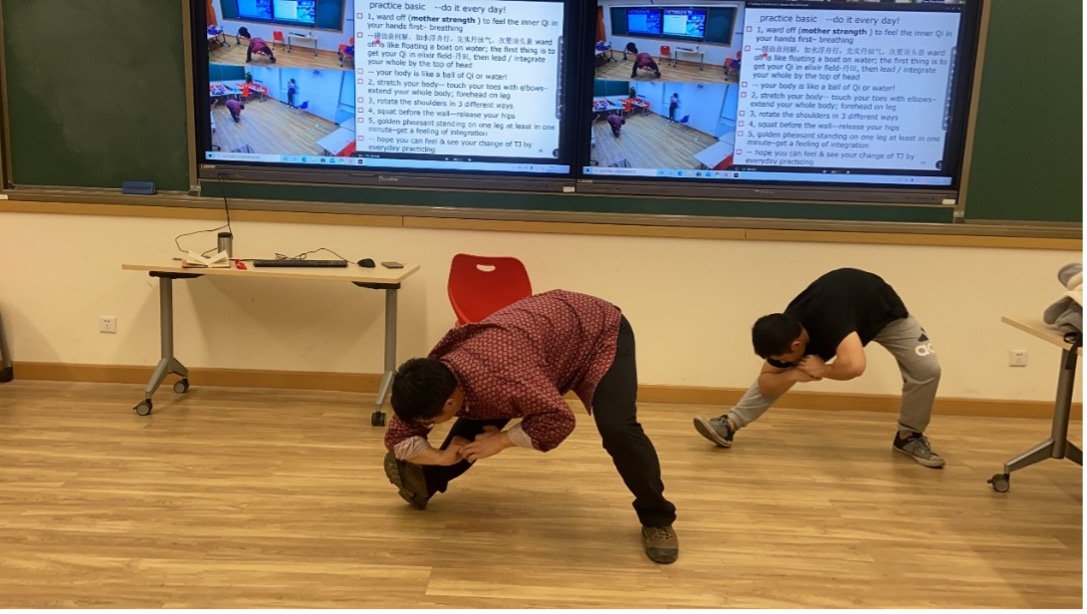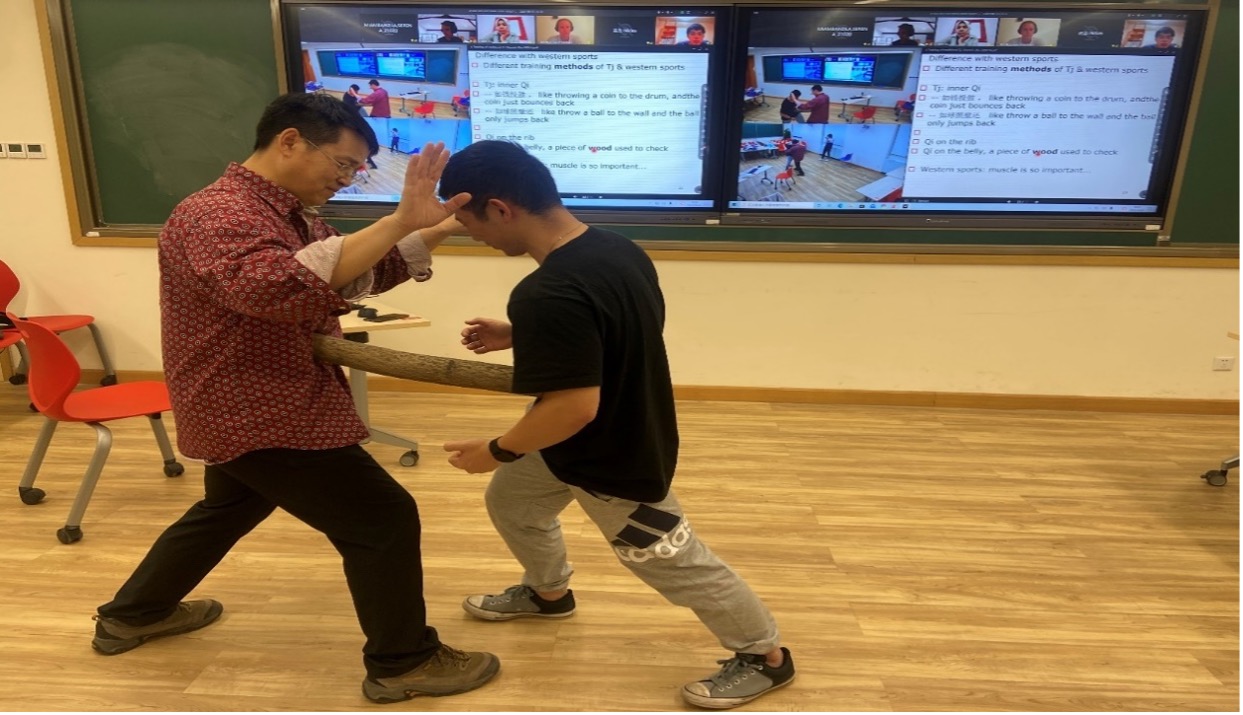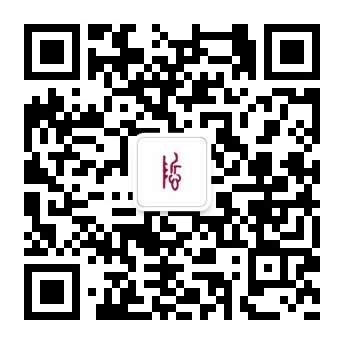International communication in Taijiquan course
International communication in Taijiquan course
Zhu Xiaomin
Department of Philosophy, Peking University / Research Center for Science Communication, Peking University

From February to June 2022, I offered the course, Traditional Taijiquan: Philosophy and Practice, for the first time in Global Open Courses Program. There were ten overseas students enrolled in this course (one offline student, nine online students, and there were also some students who occasionally came as guest students), and they were from Norway, Spain, France, Egypt, Singapore, Japan, Canada, Brazil, etc. After reviewing and marking the final papers in late June, I was pleasantly surprised to learn that some cross-cultural communication topics involved in the Taijiquan course were worth reviewing and discussing.
When designing the syllabus, based on the belief that traditional Taijiquan is a discipline for cultivating the moral self, regulating the family, and governing the state (“The civil lead the world to peace through Tai Chi”), I decided that the course should not be limited to historical materials and terminology explanations, but include a certain amount of practical experience. As the course was conducted, to my surprise, all the students were very interested and motivated to participate in the practical section. The original plan was to arrange two-thirds of the course delivering lectures and one-third of the time doing practical exercises, but we quickly made an adjustment to alternate one lecture class and one practical exercise class. When talking about the requirements for the final paper at the very beginning of the course, I suggested that students should document their personal feelings about practicing Taijiquan and try to analyze and discuss them in the final papers (within an academic research framework). Judging from assignments, most of the students did an amazing job, and it was from their perceptions and experiences that they bring forward many interesting cross-cultural communication topics.
First, I will introduce the details of our practical exercise section, which is roughly divided into four parts:
The first section is “Practice Basic”, which consists of more than ten exercises, and is done to warm up. This session includes the exercise of the mother strength of traditional taijiquan (Pengjin) to feel the movement of inner qi; flexibility exercises, such as different methods to shake shoulder in taijiquan and tongbeiquan (Through the Back Fist), press leg diagonally (use elbow tip to touch toe tip, etc.); balance exercises,such as a one-minute of golden pheasant standing on one leg; wave hands like a cloud in situ (stretch the arms by the rotating spine); kick foot in situ from the inside out, together with hands; the most fulfilling exercise, squat before the wall of Wu-style Taijiquan: standing facing the wall with toes touching it, squatting down and standing up for more than three times.

Classroom flexibility exercise: use elbow tip to touch the toe front
The so-called masters are those who practice basic skills and move on a daily basis. We require all students to practice basic moves every day and strongly advocate the concept of one-minute practice in one square meter, rendering a large block of time, professional venues, and special clothing and equipment nonessential for taijiquan practice. Everyone can do it anytime and anywhere in 1 minute and 1 square meter; every physical move can be utilized for Tai Chi practice and even daily chores can be a process to appreciate Zen. This innovative concept, which contradicts the Western perception of sports that it should be specialized and professional, gained wide popularity among students. Judging from the feedback, most of them persisted in daily practice, no matter how much time they had, and of course, they were all rewarded with something great in the end. Once, I mentioned that there is a traditional master who practices golden pheasant standing on one legwhile taking the subway, and soon there were students attempting to do the same on the train, exhibiting their serious attitude and strong interest toward taijiquan.
The second part is “Practice New”, which teaches one or two new Taijiquan movements that can be connected to each other randomly to form a routine. It mainly selects the representative movements of various branches, such as Grasp the Bird's Tail which is the mother movement of Yang style, Parry and Punch (Yang Luchan also has a nickname of Parrying and Punching Yang), White Crane Spreads its Wings, and Brush Knee and Twist Step from Yang-style Taijiquan; Lazily Tying Coat which is the mother movement of Wu/Hao style, Repulse the Monkey, and Part the Wild Horse's Mane from Wu/Hao Style Taijiquan; Wave hands like clouds, Fair Lady Works at Shuttles fromWu-style Taijiquan; Chen-style’s Crane Dancing; the Wudang Tai Chi’s double pushing and so on.
The third part is “Practice Different”, which mainly illustrates the moves that have a uniform name but are performed differently in various Taijiquan genres, in this case, students can have comprehension and feelings of specific classic moves from various perspectives. Take Wave Hands Like Clouds as an example, there are Yang-style, Wu/Hao style, Chen’s Cross legs step, Wu’s 270° style, and pushing forward style from Wudang Tai Chi, etc. Additionally, Repulse monkey is conducted in straight-line backward in Yang-style and is performed in rotation in Wu/Hao style; Brush Knee and Twist Step have variants like Yang-style 85 movement and the old sixth-part style; and there are Yang style, Wu style, and simplified 24 movement Taijiquan for Fair Lady Works at Shuttles.
Finally, comes the fourth part – “Practice Old”. It is a conclusion part to review new movements that have been learned. However, it was impossible to repeat all of them in every single class because there are a total of twenty moves as the course continues. Therefore, I asked each student to pick their favorite one and practiced it together with Chinese and foreign music appropriate to Taijiquan. This is the most active part of the class and has the most dynamic atmosphere. Some of the moves frequently picked by students are Parry and Punch, Wave Hands Like Cloud, White Crane Spreads its Wings, Grasp the Bird's Tail, Brush Knee and Twist Step, Repulse the Monkey, Double Pushing, and Crane Dancing.
For some traditional taijiquan masters, the key to learning taijiquan is to change one’s perceptions and notions. I include and concentrate on the background conceptional knowledge behind Taijiquan in every class. I explain and demonstrate it in the practical exercise sections with the performance of classic moves. For these foreign students who were new to taijiquan, the core concepts of it were amazing and they felt it reasonable to apply them in daily life. Their physical and mental painfulness and anxieties were thus relieved by practicing it, and they expressed their desire to continue their exercise even after the course. Many students mentioned their unique and special feelings about specific concepts in their assignments: slow and soft (The movements are conducted slowly with relaxed muscles, rather than straining body and mind); using will rather than strength (Rely on the will to carry out qi and the movements are all from the inside out like a spring pouring, such as the movement of Parting the Mane of Wild Horse should be like a flower blooming from heart, not rigidly nor stagnantly, but naturally); overall harmony (“One branch moving, a hundred branches shaking”. Any action is not limited to a single part of the body and should not be performed in separate intermittent steps such as one, two, three, four, etc. The force and strength should be carried out to the end with the whole body’s coordination, both internally and externally). Many students had the habit of jogging, weightlifting, playing ball games, or other western confrontational sports, but they were all impressed by traditional Taijiquan philosophy, which gave them a completely unique experience and actual benefits. The following are some representative examples:
Norwegian student M spent more than eight hours studying or working every day and felt stiffer and stiffer and out of shape. For this, he exercised every day, but the outcome was not satisfying, feeling increasingly depressed and even pessimistic with a thought like “I have not yet gotten an undergraduate degree, what I’m going to do with my physical health in twenty years” But after practicing Taijiquan for only fourteen weeks, he found his body started to become more flexible and his mental health improved.
M also suffered from a malformed clubfoot, resulting in weaker muscle strength in one leg than the other, and problems with keeping balance. For a long time, he tried to strengthen the muscles of his ill leg through various treatments and exercises, but the results were not satisfactory. After taking my Taijiquan class, he improved his sense of balance by practicing the Golden Pheasant Standing on One Leg (which requires the whole body to stay stable internally, feel comfortable, and support all directions –up and down, left and right, front and back, inside and outside, etc -- of the human body) every day. He thus realized that the balance of the body is systematic from the inside out and that the previous treatment and rehabilitation obviously could not achieve the same effect (which reminds one of the Western medical sayings: “treat the head when it hurts and treat the foot when it hurts”). He highly complimented that the results of his practice were “positive and satisfying” and he enjoyed the process so much that would vow to make it a part of his life.
Canadian student L, the only offline student, loves to lift weights and has been doing so for many years, and is quite strong and sturdy. During the flexibility exercises and Tai Chi Push Hands, it was easy to notice that his muscles were large and stiff, and his sensitivity and flexibility were affected by it. After learning and comprehending the flexibility concept, L wanted to combine Taijiquan with his favorite weightlifting sport, and therefore, “Taijiquan and Weightlifting” was his thesis title. By comparison, he found that taijiquan emphasized the integration of whole-body movements, while weightlifting focuses on isolated muscle training, often even targeting one muscle at a time. He believed that the relaxation of Taijiquan would allow his muscles to be more efficiently adjusted and rested, and also have a better awareness of his own body, thus further improving his weightlifting performance. After several months of comparative practice and reflection on Taijiquan and weightlifting, L concluded that the fact Taijiquan initiates and integrates all might by the elixir field (Dantian) was very inspiring for his weightlifting training, while the relaxation and balance of Taijiquan also helped him reduce unnecessary muscle tension, and it is easier to get inner peace and smooth negative emotions. After much comparison and coordination, he finally decided to change his weightlifting training from evening to morning, and to concentrate on taijiquan in the evening to relax, sleep sound, and recover from morning tensive training. L expressed his desire to find a better balance between “firmness” (weightlifting) and “softness” (Tai Chi).
Y is a very hardworking Spanish girl who is studying for two undergraduate degrees at the same time. She spent a lot of time every day in front of the computer, taking notes, reading papers, and writing assignments. Therefore, gradually, her body reached its limit and became exhausted, and she was even absent from class due to illness. Since last September, she has been suffering from heart palpitations, back pain, severe insomnia, anxiety, and other symptoms, although she tried swimming and exercising, the effect was not satisfying. After taking the Tai Chi class in February and practicing it every day, she noticed that “All the symptoms gradually reduced”. By practicing the movement of Waving Hands Like Clouds, with the arms driven by the rotating spine, Y perceived heat and energy flowing inside her body, and she felt excited about the appearance of “inner qi”, which is very common in taijiquan practice. Everyone feels taijiquan differently and uniquely, which is thus called “Ten peoples have ten kinds of Tai Chi”. During the semester, we have another traditional taijiquan activity every Friday at noon on campus which cooperates with the class. One of the Peking university teachers felt her feet getting hot after learning Peng Jin for the first time (it's easier for ordinary taijiquan learners to feel hot energy in their hands, but hard to get their feet hot). Everyone was in awe and they teased, “So you are the top one in a million martial arts masters!”.

Testing each other's “internal qi” in the classroom
Y practiced taijiquan seriously and diligently. She fell down many times to practice squatting before the wall. She once doubted why her teacher and other students could do it easily while she couldn’t, but she persevered and practiced even harder. Finally, two weeks before the end of the semester, she announced with great joy that she had conquered squat before the wall. Through the practice, her mental anxiety and stress were alleviated and she was pleased to find that even 5 minutes of Taijiquan practice before bedtime greatly improved her sleeping quality. Her interest thus increased, and she started to practice twice a day, devoting more time and energy to the study of taijiquan. As a result, she also realized the difference between Taijiquan and western sports: Taijiquan “was based on accepting your thoughts, relaxing your body and controlling your mind”, and “moving with synchronizing and harmony”.
J is a Singaporean Chinese student of Chaoshan origin, and she was the only student who wrote homework in Chinese (We encourage foreign students to learn Chinese as early as possible, as quickly as possible, and as much as possible to better perceive taijiquan). J had formed a habit of drinking Chaoshan kung fu tea since childhood and had twenty-year experience in making and drinking tea. After my class, she realized that there were similarities between the two, so she finally titled her dissertation “Taijiquan and Kung Fu Tea”. The process of brewing and performing kung fu tea requires consistent movements and a calm and stable state of mind, no rush, no slowness. Therefore, the “looseness” of taijiquan especially helped her tea art to be smooth and natural in the process of making tea. “It is not only a visual enhancement but also a more optimal experience for the tea maker”.
K, also from Norway, had chronic back pain and had tried various modern western medical treatments, such as muscle massages, physiotherapists, and chiropractors, but the results were unsatisfactory. After four-month taijiquan practices, his back pain problem was relieved. He was impressed by more than this: he felt actual heat and “internal qi” flowed inside his body for the first time in his life from the exercise of Pengjin (the mother strength of traditional taijiquan), squatting before the wall improved his balance, and Waving Hands Like Clouds driven by the spine force alleviated his symptoms of tennis elbow. After reading some papers, he discovered that back pain was a common social phenomenon in the West, with 1/4 of Westerners suffering from this problem. He realized that the relaxation and holistic treatment of Taijiquan which emphasized the inside-out process could potentially be the alternative for the medical treatment and rehabilitation of back pain in the West. Therefore, he concluded by recommending that Taijiquan should be included in the alternative treatment of back pain in the West, and “the vast positive effects of Taijiquan should no longer be ignored”.
Most foreign students are curious when they first encounter the concept of Taijiquan and are often surprised by the positive outcomes of diligent practice. For example, French student N mentioned several times in his homework that the “water flowing” movements and concepts of Taijiquan were very “graceful” and gave him a very distinct life experience. Compared to Chinese students, foreign students seem to be more longing for realistic outcomes and use them to prove hypotheses and theories, so they normally have better performance in my class. For example, in recent years, only one Chinese graduate student in my class every term could complete the squat before the wall in the course (this implies a suspicious attitude toward one's own cultural traditions, or even considering it as a “strange power”, which is quite similar to the situation of Traditional Chinese Medicine). Whereas, in this global class, five students completed the course in the fifth week, which is quite exciting because even the simplest move – “Asian squat” was difficult and hard for these students at the beginning.
Most students mentioned that doing western sports and yoga are relatively more likely to injure themselves, while taijiquan is far from a mechanical movement of the limbs. Its looseness, gentleness, and coordination of mind and body not only help to relieve physical injuries and discomfort, but also contribute to physical and spiritual peace and harmony. It is fair to say that through the combination of classroom discussion and practical exercise, students had a very good understanding of this traditional Chinese martial art. Heidegger said that human beings feel close to each other because of similarities, and they are curious about each other because of differences. Obviously, the different backgrounds and unique perspectives of the foreign students, in turn, enhanced our own perceptions greatly, such as Japanese student T's paper on “Taijiquan and Judo”, and Brazilian student D's paper on “Taijiquan and Brazilian Capoeira”. The quiet and gentle Egyptian girl H talked about Chinese kung fu in her homework passionately, and the Singaporean student J, who used to practice Aikido, wrote to us that her deep understanding and experience of “qi” in the taijiquan class had improved her knowledge in Aikido.
A martial arts teacher who saw my syllabus before the beginning of the school year kindly reminded me that the class content ranged from the movements and the routines to stake-standing and pushing hands were probably too much and too complicated to actually carry out in class. But I don't agree with him. In traditional taijiquan, it often takes three years to learn a single movement, and there is a saying that “You can’t go out even if you have been practicing taijiquan for ten years” (which means that you may not be able to “master kung fu” even if you have been practicing for ten years, showing the complex, exquisite and so difficult to master taijiquan). In fact, taijiquan is a process of continuous awareness, perfecting life naturally, uniting body and mind, and building self-roundedness. In short, it’s a never-ending process that whether it will be complete or not doesn’t matter. Cheng Man-ch'ing once lamented that it took him 50 years of practice before he had a real understanding of the “looseness” of Taijiquan, and it is difficult to divide the learning process to clear stages and set fixed goals. In addition, as “one tree, one bodhi, one person, one tai chi”, everyone's perception and excitement of taijiquan are different. And because of various individuality, teaching cannot and should not be standardized. At the beginning of every class, Wang Peisheng always says to his new students that “I'm here with you by fate”, and he emphasizes that learning Taijiquan “is not a matter of thinking without practicing, nor practicing without thinking”. Yang Yuting believes that traditional taijiquan does not have any routines at all, “I wave my hands and everything of tai chi is there”. There are no actual rules in taijiquan, and to move is probably the solo principle. We only open a window by providing a unique and insightful concept of Taijiquan and a colorful and individualized practice experience. Perhaps a movement or a concept will be a seed of Tai Chi that will sprout in the students' hearts. The rest is just a process to educate students according to their own specialty and let them grow naturally.
We may need to go beyond the modern Western teaching and research paradigms and principles to present our own traditional cultural course of Taijiquan in a more comprehensive, localized, and natural way, offering the world a diverse option that is colored with Chinese characteristics. Besides, a variety of unique understandings and accomplishments from overseas students in my class from the Global Open Courses program have provided new shining lights to Chinese civilization. Undoubtedly, it also further strengthened our confidence in spreading Taijiquan to the world and doing it by “walking our own path”.
Translated by WU Tianpeng
Access the Chinese version of this article here: /system/go.jsp?treeid=1041&apptype=content&urltype=news.NewsContentUrl¶m=wbnewsid=1083




